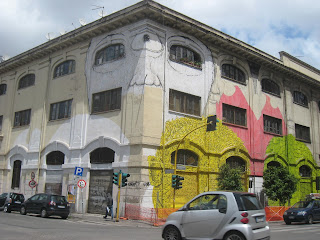 |
| Cat eats bird |
[Update - December 4, 2014 - Blu has finished the artwork on the "occupied" building below. See this link for photos of Blu working on the immense project, and of the finished work. The title of the lnk is Blu unveils a majestic mural on Via Del Porto Fluviale in Rome, Italy. As our London son put it, "Blu is considered a big deal." Glad we were there early!]
For those tired of
RST's obsession with Street Art, skip this post. But you'll be missing something, imho. As we noted recently by
reviewing Jessica Stewart's book on Rome street art,
Street Art Stories, this ephemeral form has an exceptionally good life in this, the Eternal City. And, having just returned from London and a great street art tour there (
Street Art London), we're jazzed up about the form.
 |
| oops, there goes the cat |
And so it was that we finally stopped in the Ostiense neighborhood (a run-down working class area that is being revived by youth and money, and was on its way enough that it made it into the original
RST as part of Itinerary 4) to get a close-up look at what we drive by weekly, if not daily.
The train underpasses for via Ostiense and via delle Conce
 |
| we like the see-through aspects of the art in the underpasses |

are clearly painted artistry, and they survive tagging and painting over. Some of the themes echo Rome itself, including the nearby Protestant Cemetery, where Keats's memorial has the inscription by Shelley: "Here lies one whose name was writ in water". Some are political (anti-war), and some fantastical (a unicorn, a cat eating a bird, eating a cat, etc.)..
Nearby is an "occupied" building. We've written previously about
occupied cultural spaces in Rome, both on the blog and in
RST. This is an occupied living space. We took some photos before being asked not to; so out of respect for the residents, we have not included any photos of the inside of this - in many ways - charming space. The occupants here celebrated their 10th anniversary on June 1-2, with some events open to the public. It's hard to get one's head around all that from a US perspective.

The residents of this building are painting the exterior, using the windows for eyes, and creatively bringing out faces. It's not done yet, one can tell. We like it.
But we learned a few days after our visit in early June that residents had filed dozens of complaints with the police about the dangers of the painter working high up without any protection. Add to that, say the residents, the fact that the large cornices are losing chunks of plaster - hence the closer of the sidewalks with the orange fencing you see in the photo above. The residents and local merchants are clearly frustrated by the police failure to do anything about the building. The artist, who doesn't live in the building but was asked by residents to do the painting, claims he will carry forth, even though the police have stopped him a couple times.
Check out the building, which occupies a former military installation; the ex'caserma, we're told, is what it's called (and, the woman we asked, said, "bello, no?" - "beautiful, isn't it?"). You can start at the corner of via del Porto Fluviale and via delle Conce.
 |
| and the 1950s madonnellas are still around |
Dianne
 |
Brazilian artist Herbert Baglione's work from 2011 is still
untouched. |







